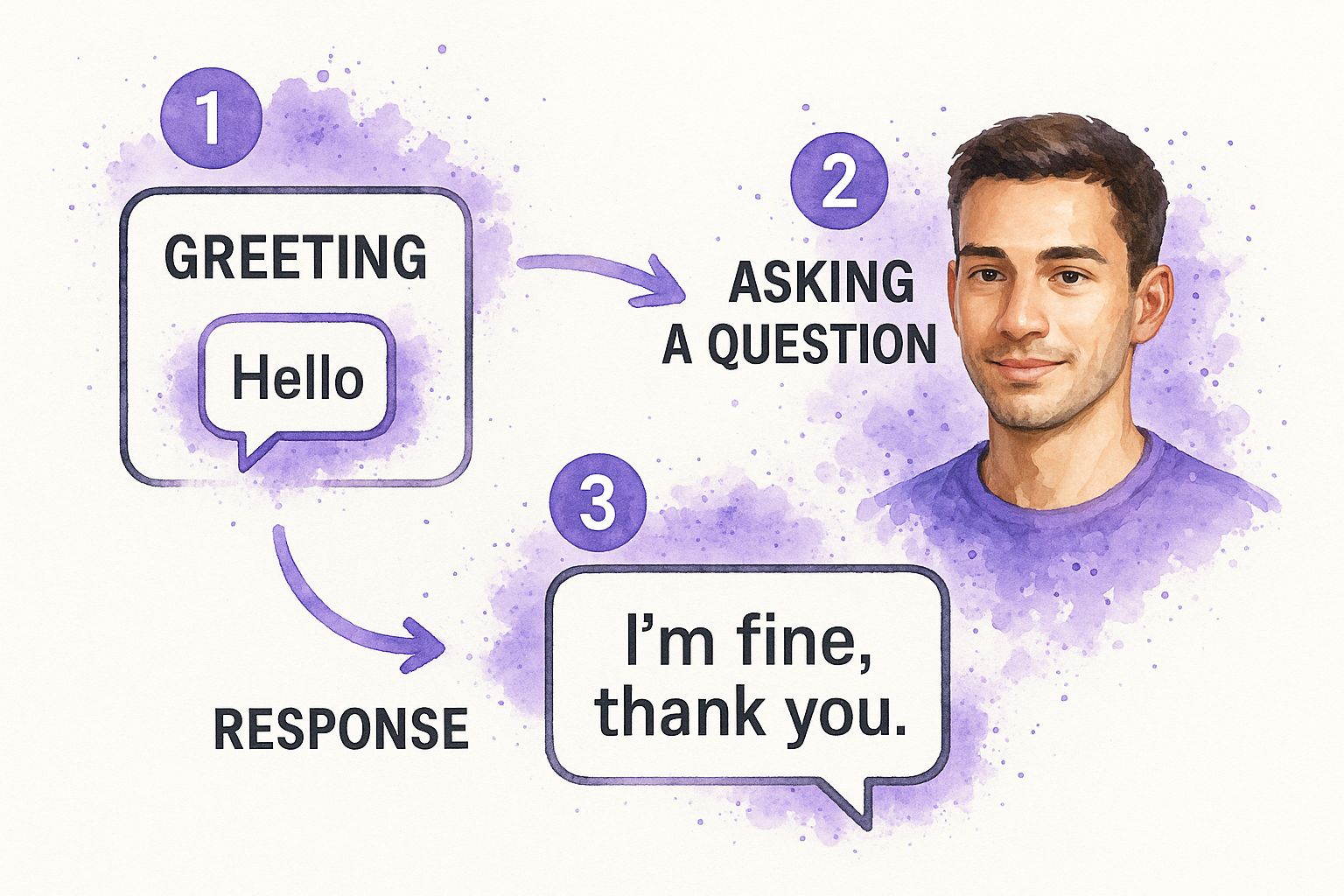English Conversation for Beginners Made Simple
A practical guide to English conversation for beginners. Learn key phrases, listening skills, and confidence-building tips to start speaking from day one.


Starting your first English conversation as a beginner can feel like a massive hurdle, but it's really just a series of small, manageable steps. The trick is to stop aiming for perfection and start aiming for connection. Once you have a handful of go-to phrases in your back pocket, you'll be surprised at how quickly you can start chatting and building real confidence.
Why You Can Start Speaking English Today
Let's be honest, the idea of jumping into a real conversation in a new language can be terrifying. What if I make a mistake? What if I sound silly? What if I don't understand them? These are the fears that hold so many learners back.
The truth is, real, noticeable progress doesn't come from memorizing grammar rules. It comes from actually using the language, even imperfectly. It's time to shift your thinking.

It's About Connection, Not a Test
Think of conversation less like an exam you can fail and more like a bridge to another person. Your goal isn't to deliver a flawless speech; it's to share a thought, ask for directions, or just exchange a friendly word. That’s it.
This guide is built to get you there with practical, real-world tools. We’ll skip the complicated theory and focus on what works:
- Mastering the Basics: We'll cover the core greetings, questions, and replies that are the building blocks of almost any conversation.
- Finding Your Practice Ground: You need a low-pressure place to try things out. This could be with a language partner or even with AI-powered practice apps like TalkEasy.
- Stacking Small Wins: Every short, successful chat you have is a victory. These little wins build the momentum you need to keep moving forward.
You're in Good Company
Here’s something that might surprise you: you are far from alone. In 2023, there were an estimated 1.5 billion English speakers globally, but only around 380 million of them grew up speaking it. That means the vast majority of English conversations happening right now involve learners, just like you.
A fascinating statistic shows that a mere 4% of English conversations worldwide happen between two native speakers. The rest are between non-native speakers, solidifying English as the world's go-to language for international connection.
This completely changes the dynamic, doesn't it? You're not an outsider trying to break into some exclusive club. You're joining a massive global community that uses English to get things done and connect with others. You can find more cool facts about global English use over at ecenglish.com.
Most people you talk to will be patient and understanding because they get it. They've either been in your shoes or have spoken with plenty of people who have.
So, let's get you equipped with the tools and the mindset to start speaking today. Forget about being perfect. Focus on making progress, one conversation at a time.
Your Foundation of Essential English Phrases
When you're just starting out, the idea of having a full English conversation can feel intimidating. The good news? You don't need to know thousands of words to get started. What you really need is a small, reliable toolkit of phrases that work in almost any situation.
Think of these as your conversational Swiss Army knife—versatile, practical, and easy to grab when you need them. It's not about memorizing a dictionary; it's about mastering the key phrases that unlock real, everyday interactions.
Look, the basic flow of a conversation is often simpler than you think. This visual breaks down a fundamental exchange into three clear parts.

That simple greeting-question-response sequence is the backbone of so many daily interactions. It proves you only need a few key elements to get a conversation off the ground.
Mastering Greetings and First Impressions
Making a good first impression often starts with a confident "hello." But to sound truly natural, you'll want a few alternatives up your sleeve. Having options helps you match the formality of the situation and avoid sounding robotic.
A simple "Good morning" or "Good afternoon" works perfectly in more formal settings, like when you walk into a shop or join a business call. But when you're chatting with friends or people your own age, you can loosen up with phrases like:
- "How's it going?"
- "Hey, how are you doing?"
- "What's up?" (This one is very informal, so save it for casual situations!)
Pay attention to how native speakers greet you. You'll start to notice patterns, and you can begin to incorporate those same phrases into your own vocabulary. It’s a great way to learn by listening.
Essential Phrases for Asking for Help
One of the biggest fears for any language learner is getting stuck and not knowing what to say. Here's a secret: the most powerful skill you can develop is learning how to ask for help gracefully. Native speakers do it all the time, so it's a completely normal part of any conversation.
Instead of just blurting out "I don't understand," which can feel a bit abrupt, try these more specific and polite phrases:
- "Sorry, could you say that again, please?" This is perfect if you just didn't catch what they said.
- "What does [word] mean?" Use this the moment you hear a word you don't recognize.
- "Could you speak a little slower, please?" This is an incredibly useful request, and most people are more than happy to help.
Using phrases like these shows you're engaged and really trying to understand. It turns a moment of confusion into a chance to connect and learn something new.
The goal isn't to understand 100% of every conversation right away. The real goal is to learn the tools to navigate the moments when you don't understand. That's where true conversational skill is built.
Keeping the Conversation Going
Okay, so you’ve said hello. Now what? The secret to keeping a chat alive is using phrases that show you're listening and invite the other person to share more. These are the little things that turn a simple exchange into a genuine conversation.
A great technique is to use follow-up questions or statements that show your interest. For instance, if someone mentions they had a busy weekend, you could respond with:
- "Oh, really? What did you get up to?" This open-ended question encourages them to give you more than a one-word answer.
- "That sounds interesting. Tell me more." This is a direct, friendly invitation for them to keep talking.
- "In my opinion..." or "I think that..." are great ways to share your own thoughts without cutting them off.
Don't forget the power of simple "reaction" words! Sprinkling in words like "Wow!", "That's cool!", or "I see" shows you're actively listening. These small additions make the conversation feel so much more dynamic and are a key part of any English conversation for beginners.
To help you get started, here's a quick reference table with some go-to phrases for common situations.
Your Go-To English Conversation Starter Kit
This table summarizes some essential phrases for beginners, offering both a basic version and a more natural-sounding alternative to help you level up your skills.
| Situation | Beginner Phrase | Natural-Sounding Alternative |
|---|---|---|
| Greeting Someone | Hello. How are you? | Hey, how's it going? / How have you been? |
| Asking for Help | I don't understand. | Sorry, could you say that again? / What does that mean? |
| Agreeing with Someone | I agree. | That's a good point. / I feel the same way. |
| Sharing Your Opinion | I think... | The way I see it... / In my experience... |
| Ending a Conversation | Goodbye. | It was great chatting with you! / Talk to you later! |
Keep this "kit" handy as you practice. Over time, these phrases will become second nature.
Mastering these core phrases gives you a solid foundation. From here, you can start practicing active listening and building more complex sentences. As you build confidence, you can try out these phrases in a low-pressure environment on platforms like TalkEasy, which offers a safe space to practice with simulated conversations.
Want to Speak Better? First, Learn to Listen.
It sounds a bit backward, doesn't it? To become a better speaker, you need to become a better listener. But trust me on this one—it’s the most overlooked secret for anyone just starting with English conversation for beginners.
A great conversation is a two-way street. When you shift your focus from "What do I say next?" to truly hearing what the other person is saying, everything changes. You start absorbing the real rhythm of the language, picking up new vocabulary naturally, and responding more thoughtfully. It takes all the pressure off.

Ditch the Panic: Hunt for Keywords
One of the biggest hurdles for beginners is feeling like you have to understand every single word. That's a recipe for anxiety, and it actually makes it harder to follow along. The trick is to relax and just listen for the most important words—the keywords.
Keywords are the nouns, verbs, and adjectives that carry the core meaning. For instance, if someone says, "Yesterday, I went to a fantastic restaurant downtown and ate a delicious pizza," what really matters? The keywords are "restaurant," "downtown," and "pizza."
Even if the other words were a blur, you've got enough to go on. You can easily ask, "Oh, a pizza restaurant downtown? What's it called?" This keeps the conversation alive and helps you build on what you did understand.
Fill in the Blanks with Context Clues
Once you've snagged a few keywords, it's time to play detective. Use the context clues all around you to piece together the rest of the story. This isn't just about the words; it's about the non-verbal cues, too.
What's their tone of voice like? Are they smiling and speaking with energy? It's probably a positive story. Are they shrugging or pointing at something? Their gestures can give you huge hints about what they mean.
Active listening isn't about having a perfect vocabulary. It's about using all the available information—words, tone, and body language—to get the message. Mastering this skill melts away anxiety and makes you a much more confident communicator.
Suddenly, a conversation feels less like a stressful test and more like a fun puzzle you're solving together.
Practical Exercises to Train Your Ear
Getting better at listening takes practice, but it doesn't have to be a chore. Your goal is to get your ear comfortable with different accents, speeds, and conversational styles. You can sneak these exercises into your day without much effort.
Here are a few simple but powerful ways to get started:
- Podcast Shorts: Find a short English podcast (think 5-10 minutes) on a topic you actually find interesting. Listen to it once without looking at anything. Then, listen again while reading the transcript to catch what you missed.
- The Movie Scene Method: Pick a short scene from an English movie or TV show and watch it with the subtitles on. Then, immediately watch it again with the subtitles turned off. This is fantastic for connecting the written word to its natural, spoken sound.
- Music and Lyrics: Pop on an English song and pull up the lyrics. It's a fun, low-pressure way to learn idioms and casual phrases you'd never find in a textbook.
How Listening Makes You a Better Speaker
When you really dedicate time to active listening, the benefits to your own speaking ability are huge. You start to absorb the natural flow, intonation, and rhythm of English—the stuff that’s almost impossible to learn from a book. Before you know it, you're naturally using new phrases and sentence structures without even trying.
But here's the real magic: being a good listener makes people want to talk to you. They feel heard and understood, which makes them more patient and engaged. This creates a supportive, positive space for you to practice. It’s a fantastic cycle: better listening leads to better conversations, and better conversations build unstoppable speaking confidence.
For a safe place to put these skills into practice, you can even try simulated conversations with AI tools like TalkEasy.
How to Keep the Conversation Flowing Naturally
The biggest fear for anyone learning English isn't making a grammar mistake—it's the dreaded awkward silence. That moment when the chat just… dies. The good news is that keeping a conversation going is a skill you can learn, and it's much easier than you probably think.
It’s not about being a brilliant storyteller or having a massive vocabulary. It all comes down to a few simple, proven tactics that show you're engaged and invite the other person to share more. These techniques stop conversations from hitting a dead end and can turn a simple exchange into a real connection.
Master the Art of Open-Ended Questions
One of the easiest yet most powerful changes you can make is to stop asking questions that get a simple "yes" or "no" answer. These are called closed questions, and frankly, they are conversation killers.
Instead, get comfortable using open-ended questions. These are questions that usually start with words like:
- What
- Why
- How
- Where
- When
Think of these words as keys that unlock longer, more detailed responses. Your conversation partner can't just nod and say "yes"; they have to explain, describe, or share their thoughts.
Let’s look at how this plays out in a real chat.
| Closed Question (Avoid) | Open-Ended Question (Use This!) |
|---|---|
| "Did you have a good weekend?" | "What did you get up to over the weekend?" |
| "Do you like movies?" | "What kind of movies are you into?" |
| "Was your trip nice?" | "How was your trip? Tell me about it!" |
See how the questions on the right just naturally pull a better story out of someone? This one small shift can completely change the dynamic of your conversations.
Use Echoing and Follow-Up Questions
A fantastic way to show you're actually listening is to "echo" or repeat a key piece of information someone just shared. It instantly confirms you understood them and gives you the perfect launchpad for a follow-up question.
For example, imagine a friend says:
- Them: "I was so busy this weekend. I helped my brother move into his new apartment."
Instead of a generic "Oh, that's nice," you can use the echo technique to dig a little deeper.
- You: "Oh, your brother got a new apartment? Where did he move to?"
- Or maybe: "Moving is so much work! How is he liking the new place?"
This simple trick creates a natural back-and-forth rhythm. You’re not just taking turns talking; you're building a conversation together based on what the other person is actually saying. It shows you're genuinely interested.
The best conversations feel like a game of catch, not a series of interviews. By building on what your partner says, you're tossing the ball back to them in a way that’s easy and enjoyable to continue.
Briefly Share Your Own Experiences
Remember, a conversation is a two-way street. While asking good questions is crucial, you also have to share a little bit about yourself. This is how you build rapport and make the chat feel balanced and personal.
The key is to keep it short and relevant. You're not trying to hijack the conversation; you’re just adding a bit of your own experience to connect with what they said.
Let’s go back to the moving example:
- Them: "Yeah, his new place is downtown. It was a lot of work, but it looks great."
- You: "That’s awesome. It reminds me of when I moved last year. Finding a good place downtown can be tough! What does he like most about it so far?"
Notice how the personal story is just a quick bridge to another question about them? This makes the conversation feel warm and friendly, not like an interrogation. For learners who want to develop this skill further, our guide on how to speak English with fluency offers more advanced tips on storytelling and natural speech patterns.
By combining open-ended questions, active listening, and brief personal stories, you'll have a powerful toolkit for preventing those awkward pauses. These strategies will turn a potentially stressful english conversation for beginners into something you can actually enjoy.
Where to Practice Your English Speaking Skills
Knowing a few key phrases and being a good listener are great starting points, but theory will only take you so far. To really build confidence, you need a safe and encouraging place to put your skills into action. The great news is you have more options than ever, and many of them don't even require you to leave home.
The whole point is to build a consistent practice habit that feels good, not stressful. It’s all about finding low-pressure environments where you can experiment, make mistakes, and see real progress without worrying about being judged.

Digital Tools for Judgment-Free Practice
For a lot of new learners, the biggest hurdle is the fear of speaking with a real person. I get it. This is where modern technology can be a real game-changer. AI-powered conversation platforms give you a private space to practice speaking out loud, get comfortable with new phrases, and build that crucial conversational muscle memory.
AI tutors like TalkEasy let you have simulated conversations about all sorts of everyday topics. You can practice ordering food, making small talk, or discussing your hobbies, all while getting instant, friendly feedback. This kind of practice is incredibly valuable for building that initial layer of confidence before you start talking to real people.
Finding Your Conversation Community
Once you're feeling a bit more sure of yourself, the next natural step is to start talking with others. The trick is to find supportive communities where everyone is there for the same reason: to learn.
- Language Exchange Apps: Platforms like Tandem or HelloTalk are fantastic. They connect you with native English speakers who want to learn your language, creating a balanced partnership where you both get to be the student and the teacher.
- Online Communities: Search for forums or social media groups for English learners. These are goldmines for asking questions, sharing your wins, and sometimes even finding a partner for a quick video call.
- Local Conversation Clubs: Don't forget to look offline! Check your local community centers, libraries, or universities. Many offer free or cheap conversation clubs where you can practice in a relaxed, friendly group setting.
And the long-term payoff for all this practice is huge. High English proficiency is directly linked to better economic opportunities—fluent speakers can sometimes earn a wage premium of up to 30%. Every conversation you have is a small step toward those bigger goals. You can check out these global English learning insights to learn more about what it takes to hit those conversational milestones.
The goal isn't to find a perfect, native-speaking tutor right away. It's to find a comfortable space where you can simply talk. Consistency is so much more important than perfection, especially when you're just starting out.
Weaving Practice into Your Daily Routine
Believe it or not, you don't always need a conversation partner to practice. Some of the most effective methods involve just talking to yourself. This technique, often called "self-talk," is a powerful way to get your brain to actually think in English.
Try narrating what you're doing throughout the day. While you’re making coffee, say it out loud: "Okay, now I'm getting a mug. I'm pouring the hot water in." It feels a little silly at first, but it gets your mouth used to forming English words and sentences. For more ideas like this, check out our guide on English speaking practice for beginners.
When you combine these methods—using AI tools for private practice, engaging with communities for real-world experience, and using self-talk for daily reinforcement—you create a powerful learning system. It lets you build confidence at your own pace and turns speaking English from a scary task into a manageable, and even fun, habit.
Common Questions About Learning to Speak English
Diving into English conversation is exciting, but it’s totally normal to have a ton of questions. Feeling stuck or unsure is just part of the process for every single person learning a new skill. Let's tackle some of the most common hurdles you might be facing and give you some real, practical answers to keep you moving forward.
How Can I Get Over My Fear of Making Mistakes?
First things first, we need to completely change how we think about "mistakes." A mistake isn't a failure. It's proof that you’re trying, learning, and pushing yourself. I guarantee you, every fluent English speaker you admire has made thousands of mistakes along the way.
The trick is to shift your focus from perfection to connection. Seriously, if you got your idea across and the other person understood you, that’s a win. The grammar details are secondary to successful communication.
To start building this new mindset, practice in low-stakes situations. Chatting with an AI tool or finding a super patient language partner is a brilliant way to build your confidence without that fear of being judged. You’ll quickly find that most native speakers are just happy you’re making the effort to speak their language.
What Is the Fastest Way to Get Better at Speaking?
There's no magic wand for instant fluency, but consistency is the next best thing. This is, without a doubt, the most critical factor for making quick progress. Try to speak every single day, even if it's just for 15 minutes. Those small, daily sessions are far more powerful than one long practice marathon once a week.
Pair that daily habit with active listening. Watch English TV shows or listen to podcasts about things you actually find interesting. This helps tune your ear to the natural cadence and rhythm of the language.
Here's a pro tip: Stop learning single, isolated words. Instead, focus on learning whole phrases. This makes your speech sound much more natural because you're learning words already wrapped in their correct context.
Finally, don't be afraid to ask for feedback. A good tutor or an AI program that offers gentle corrections can help you zero in on your weak spots and turn them into strengths, which really speeds up the whole process.
I Don’t Know Any Native Speakers—How Can I Practice?
This is a huge one for a lot of learners, but thankfully, location isn't the barrier it used to be. The internet has blown the doors wide open for practice opportunities.
Here are a few proven ways to find people to talk to:
- Language Exchange Apps: These platforms are gold. They connect you with native English speakers who want to learn your language, creating a perfect two-way street where you both get valuable practice time.
- Online Communities: Jump into forums or social media groups made for English learners. They’re fantastic places to ask questions, track your progress, and find people willing to hop on a quick video call.
- Practice by Yourself: Don't knock it 'til you try it! Reading a book or an article out loud is surprisingly effective. You can even just describe what you see around you in English. It builds crucial muscle memory in your mouth and brain, all with zero pressure.
And, of course, AI conversation partners give you a safe, on-demand space to practice anytime. It's the perfect warm-up before you start chatting with real people. If you want to explore this more, check out our detailed guide on how to improve English speaking from anywhere.
How Long Does It Take to Become Conversational in English?
The honest answer? It's different for everyone. Your timeline depends on your starting level, how often you practice, and the methods you're using.
As a general benchmark, some studies suggest it takes about 600 to 1,000 hours of focused study and practice to hit a solid intermediate (B1) level. At that point, you can handle most day-to-day conversations and share your opinions on familiar subjects.
But instead of getting bogged down by a big, fuzzy goal like "fluency," I'd suggest setting smaller, more concrete goals. Things like:
- Successfully order a coffee in English.
- Have a five-minute chat about your weekend.
- Ask someone for directions and actually understand their reply.
Celebrating these small wins is the key to staying motivated. Each one is a milestone that proves you're making real, tangible progress. Focus on the journey, and you'll get where you want to go.
Ready to put these answers into action? TalkEasy offers a judgment-free space where you can practice speaking English every day. With our AI conversation partner, you can build confidence, get instant feedback, and start speaking from day one. Try it for yourself at https://www.talk-easy.com.